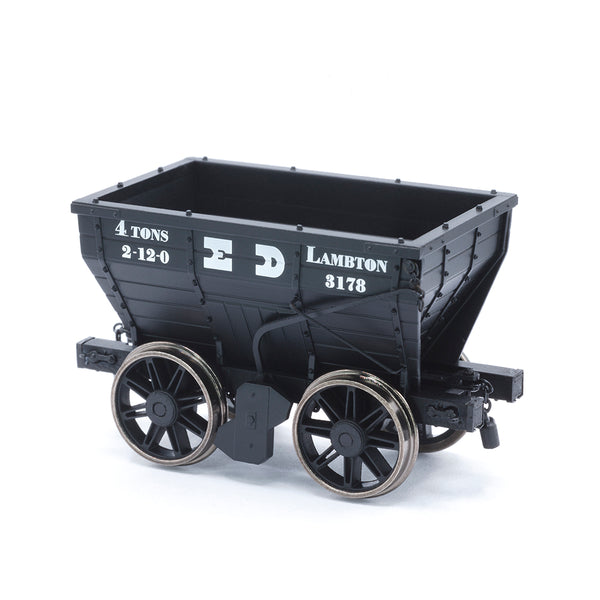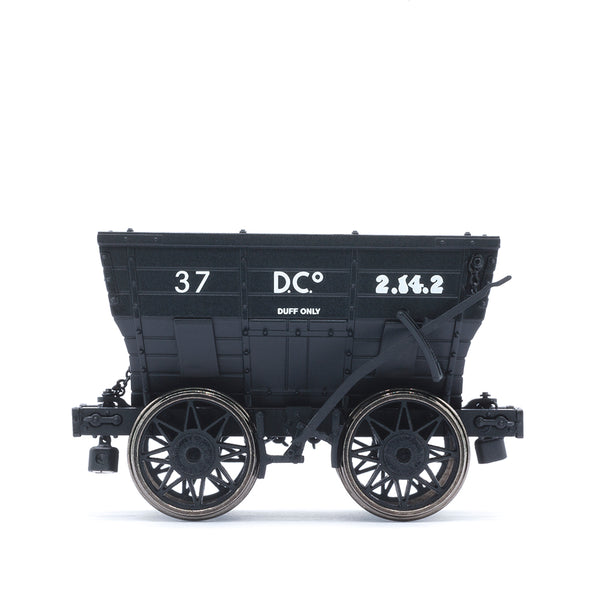Decorated Chaldrons Part 2 - Packs E - J
Following on from our Part 1 blog on the history and decoration images of our Chaldron wagons, we reveal the outstanding packs and chart their histories.
These cute hoppers may have been the rail equivalent of the Ford Model T (You can have any colour you want, as long as it's black!) but what they lack in colour they more than make up for with interesting lettering and markings.
They also win first prize for the worlds cutest item of rolling stock, right? They really are teeny!

Pack E: Wearmouth Coal Co. - Three ex-NER P1 style Chaldrons, dating from the period 1900 to late 1920s/early 1930s.

Originally called Pemberton Colliery until 1847, the first shaft was sunk in 1826 on the north bank of the River Wear and the company’s staithes that served the Wearmouth Colliery were almost exactly opposite those of the Hetton & Lambton Staithes.
A fleet of early Chaldrons served these staithes until 1900, when the company opened Hylton Colliery and a vast number of ex-NER P1 type Chaldrons were purchased, all being numbered in the 14xx series.

Wearmouth Coal Co. had running rights over the NER lines between Hylton and Wearmouth and their waggons were hauled by Colliery owned locomotives utilising their own brake vans, until 1914 when they were restricted to internal use only, being replaced by 10t coal hoppers.
The Chaldron fleet disappeared from the books sometime during the late 1920s/early 1930s and the site of Wearmouth Colliery is now occupied by Sunderland AFC’s ‘Stadium of Light’.
Pack F: Lambton Collieries (Earl of Durham’s Collieries) - Three ex-NER P1 style Chaldrons in pre-1896 livery.

One of the oldest mining concerns in the North East, the commercial extraction of coal was developed by John Lambton on his parkland surrounding Lambton Castle in the Wear Valley. In 1783, the first of seven pits was sunk in the village of Burnmoor which together with Lambton Park, Lumley, Littletown and Sherburn made up the concern of Lambton Colliery.
The railway system serving the colliery had its roots with the 1737 built horse-drawn tramway between Fatfield and Cox Green and in 1819 Lord Lambton (the Earl of Durham) bought the Newbottle waggonway, and connected this to the Lambton Railway with a line between Burnmoor and Philadelphia.

The company now had a direct route from its collieries to the River Wear, where it constructed Lambton Staithes on the south bank of the river and the waggons were hauled by Lambton owned locomotives and backed by the company’s own brakevans.
The Earl of Durham’s collieries purchased vast numbers of ex-NER P1 type Chaldrons, both from private dealers like Cooks Ironworks of Washington and from the NER direct, with the last order of 300 Chaldrons for the company being made in 1896. In that year, the struggling company was bought out by James Joicey and renamed as Lambton Collieries Ltd and the ED legend was gradually replaced by an LC legend in the same style of lettering.
Pack G: Stella Coal Co. - A perfect example of how Chaldrons were kept in service, being repaired as necessary, until they were fit only for firewood. Three S&DR style Chaldrons, circa 1950.

Coal mining in the Ryton area of Northumbria can be dated back to at least the late 14th century and by the 17th century ownership rested with the powerful Vane family, but various leases expired in the early 1830s and the colliery lay dormant for several years until, in 1839, the lease was taken up by John Buddle, T. Y. Hall, and A. L. Potter, under the name of the Stella Coal Company.
The S.C.C’s railway system covered four collieries, those of Addison, Emma, Greenside and Stargate, with Addison being adjacent to the NER and Emma/Greenside being served by two branchlines that converged at Stargate, which was linked to Addison/the NER by a self acting incline until well into the late 1950s.

Chaldron usage was mainly limited to supplying coal for the boilers at Stargate and Emma post-1914, as well as acting as service waggons and as runner vehicles on the Stargate incline, but from 1946 until closure in 1961, locomotive haulage replaced stationary engine working and Chaldrons could be seen with both S.C.Co. and NCB legends in this period.
Pack H: Londonderry Collieries - Three 4T ‘Black Waggons’, in two body styles, circa 1960s.
Pack I: Seaham Dock Co. - Three 4T ‘Black Waggons’, in three body styles, circa 1950s.
Pack J: Vane-Londonderry Collieries - Three 4T ‘Black Waggons’, in two body styles, circa 1960s.

Seaham Harbour was the final stronghold of the Chaldron waggon fleets and the Vane-Tempest/Londonderry/Seaham Dock Co. fleets could almost be considered to be one, such was the intertwined history of the collieries. The South Hetton Coal Company line served South Hetton, Murton and Haswell pits, while the Vane-Tempest family controlled pits in the Rainton, Penshaw and Pittingdon areas.

Through marriage to the Marquis of Londonderry, the Vane-Tempest lineage carried the Londonderry title and ownership of the area’s collieries and the railway became collectively known as the Londonderry system.

Such was the vastness of the system, and such was the requirement for Chaldron wagons, that a new improved style of 4t ‘black waggon’ was created during the 1860s; giving rise to the familiar family of rolling stock that is still colloquially referred to as the Chaldron and that was still operating in the Seaham Harbour area until 1976.

The VL legend dated from the mid-1880s and lasted until the turn of the century, when new waggons were built with the L legend. With the Seaham Harbour Dock Company being incorporated in 1898 to take over and improve the existing harbour and docks at Seaham Harbour, and which subsequently took over ownership of the dock railways from the Marquis of Londonderry, Chaldrons also appeared with the D.Co. legend and mixed freely with the surviving VL and newer L waggons.
In the coming weeks we will have a video demonstration of our gorgeous magnetic coupling system, including the NEM attachment for locomotives and other wagons, so keep an eye out for that! Delivery is on track for Q2 2022.
Just click here if you wish to pre-order any of our Chaldron packs, just £44.99 per triple pack with 10% off when you order two packs or more!






